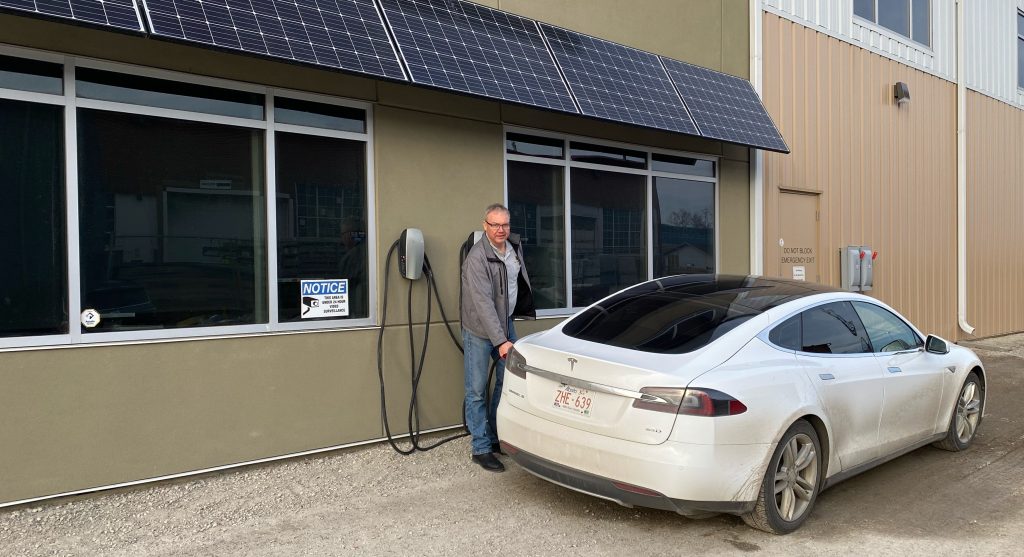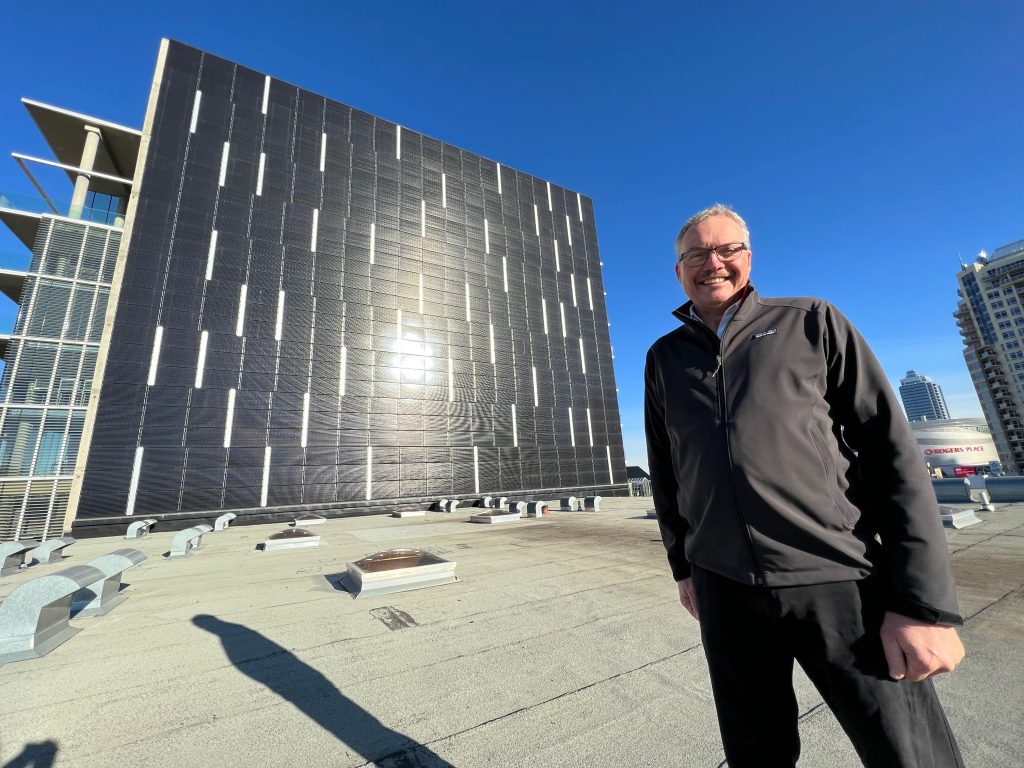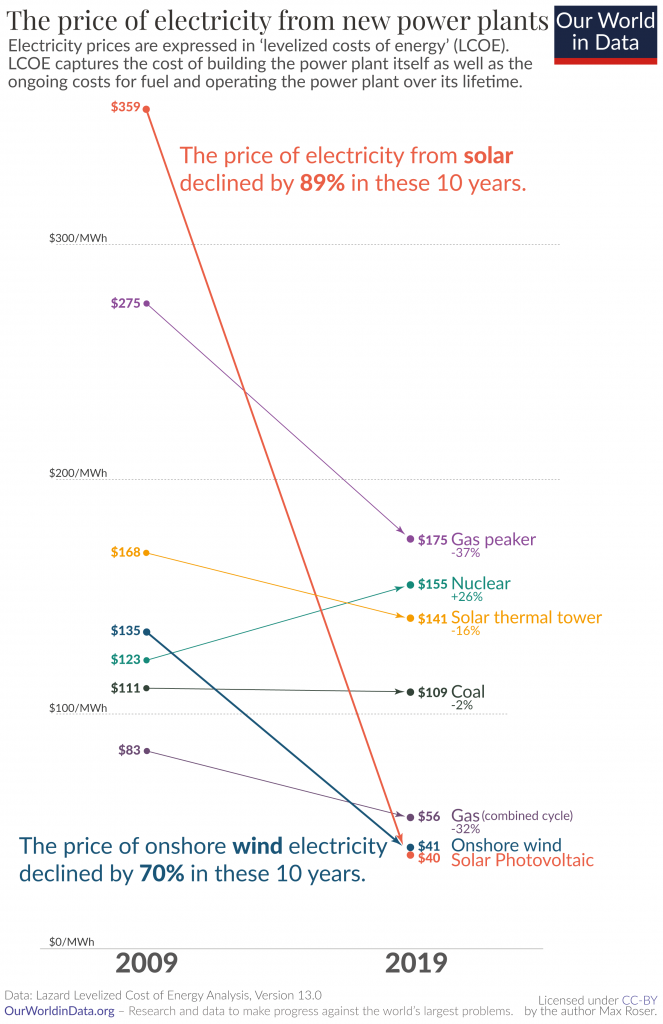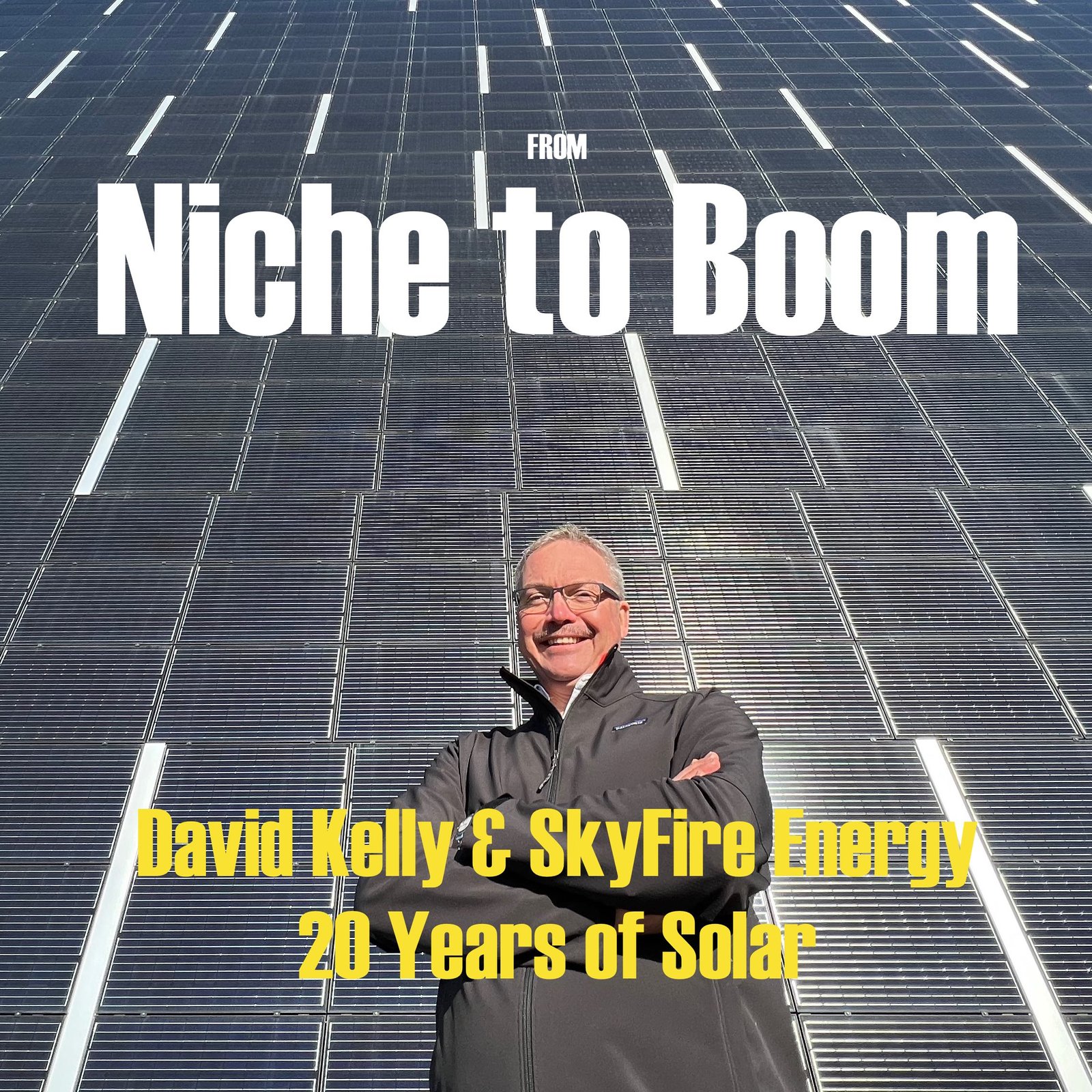By David Dodge, GreenEnergyFutures.ca
In 20 years David Kelly went from being inspired by the potential of solar and eeking out a living selling small solar systems to becoming CEO of SkyFIre Energy a successful company that has installed thousands of solar systems and is now at the center of a solar boom in Alberta.
David Kelly developed a passion for solar energy at a very early age. His grandfather built a solar pool heater 45 years ago and Kelly remembers being “amazed at the power of the sun.”
Kelly had a knack for numbers and headed off to study Engineering at the University of Waterloo where he helped build the first solar car for the GM Sunrayce in 1990.
He began his career designing bomb suits, ballistic vests, and helicopter armour for Canada’s Sea King Helicopters that went to the Gulf War.
He found himself commuting 2.5 hours down the Don Valley Parkway in Ontario from work and his wife convinced him to move on. They moved to Calgary and Kelly started doing consulting work for thermal power generators and there Kelly got to know “some of the solar guys.”

In 2001 he installed the 10th grid-tied solar system in Alberta on his home in Calgary. Kelly had to negotiate a sea of permitting processes from wires owners and regulators that had little interest in solar. It was hard to get equipment and it was expensive.
In short, solar was hard in the early days and still, David Kelly thought “there was a huge future in solar.”
Back in the early 2000s, solar thermal was all the rage. Solar thermal uses modules or later evacuated tubes to gather the heat of the sun and heat up a liquid that is circulated through the modules to provide hot water for heating, hot water, or industrial processes.
“We installed solar hot water systems on homes, it was about 90 per cent of our business,” says Kelly. SkyFire even landed the pioneering Drakes Landing project in Okotoks, Alberta. A 52-home subdivision is connected to a district solar thermal energy system which stores energy down boreholes in the summer and draws heat in the winter.
The enthusiasm for solar thermal heating in northern climates faded quickly as the price of solar PV modules began to decline.
“As solar module prices fell, the solar thermal market or the solar hot water market just fell off a cliff,” says Kelly.

Price is the big tipping point for solar
The price of solar began to come down, a trend that continues to this day. “That was the big thing,” says Kelly.
The next big tipping point was the launch of Alberta’s Microgeneration Act. “Prior to that, a lot of wire owners and utilities wouldn’t allow you to sell back into the grid. So, you’re either off-grid or you didn’t have solar,” says Kelly.
Still, the economics of solar in Alberta were “horrible in the beginning.”
“Prior to the Green Energy Act in Ontario, the largest consumer of solar modules in Canada was the Alberta oil patch,” says Kelly.
The Green Energy Act was launched in Ontario was launched in 2009 and caused a rush on solar as the province offered up feed-in-tariffs of up to 80 cents per kilowatt-hour in the beginning.
Not many contracts were issued at that level but the crazy high price armed solar opponents who essentially said the high price proved solar wasn’t viable.
But the price of solar began a major decline at the same time and the future of solar in Canada was assured.
While Ontario was dishing out the generous feed-in-tariffs David Kelly and other advocates of solar such as Gordon Howell were left rationalizing solar as a good investment even in Alberta with its cheap, coal-fired electricity. I remember their calculations that massaged the numbers to come up with 17-year payback on solar systems in Alberta.
Kelly smiles being reminded of these stories and says “Seventeen years is not bad for solar at the time because you know you’ve got a module with a 25-year warranty.” He’s still got the faith!
But the price of solar has fallen precipitously since then.

The precipitous decline of solar prices
Between 2009 and 1019 the price of electricity from solar fell from 35.9 cents per kilowatt-hour to 0:04 cents and as Kelly says “price is everything.” Already in 2019, the levelized cost of energy was lowest for solar.
In 2009 there was another breakthrough for David Kelly and SkyFire Energy as projects started getting larger and larger.
“Our first large-scale project was a 259-kilowatt project on the Okanagan College Center of Excellence,” says Kelly.
“I can’t remember how many modules there were, you know, tractor-trailer loads. It was huge for us. And that was our big, first big scale project,” says Kelly.
Then SkyFire landed the SunMine Solar Project in Kimberly BC. It was built on land provided by Teck Resources Ltd. and at one megawatt with 4,032 solar sun-tracking solar modules was British Columbia’s largest project at the time and the largest solar tracking project in Canada.
The project was a big deal at the time and since has been sold to Tech Resources.
Green Acres signaled a new unsubsidized future for solar in Alberta
Then SkyFire Energy worked with the Green Acres Hutterite Colony near Bassano, Alberta to develop the two-megawatt Green Acres Solar Project. The project was the largest of its kind in western Canada at the time and it was built without subsidies.
The colony had to divide the project in two at the time because Alberta’s microgeneration regulation only allowed projects of up to one megawatt. So, one half of the project powered the Hutterites recycling business and the other half powered farm operations and residences. Alberta has since increased the maximum size of microgeneration projects to five megawatts.
“So that project, built without subsidies, was able to deliver energy cheaper than they were getting it from the grid. And so it was that whole cost thing, and that was really what drove it.”
This unsubsidized project sent ripples through the solar industry in Alberta and Canada.
Just five years later the largest solar project in Canadian history was built by Capstone Infrastructure in Claresholm, Alberta. At 132 megawatts the project has 477,198 solar modules and produces enough electricity to power 33,000 homes in Alberta. Sheep graze on the solar farm, just like they did before solar and the landowners have a whole new source of income.
The industry is now creating jobs, has spawned hundreds of companies, and is in the midst of a veritable solar boom in Alberta.
“And we’re seeing that happen today,” says Kelly. Un-subsidized projects like the Greengate Power Travers solar project near Vulcan, is 465 megawatts, fully 350 per cent bigger than the previous largest solar project in Canadian history.
“It’s an absolutely massive project unsubsidized and is able to deliver energy to Amazon and the grid cheaper than you can buy it from the Alberta grid,” says Kelly.
Green Energy Futures CKUA Radio Podcasts
SkyFire Energy occupied a tiny niche 20 years ago.
“It was probably 15 years too early, but it allowed us to grow as a company and learn a lot and be prepared for what is now a solar boom in Alberta,” says Kelly.
“It just grew and grew, took over my life,” says Kelly. The company now has 92 staff and four offices in Regina, Calgary, Edmonton, and. Penticton. “It’s an amazing story for energy in Alberta,” says Kelly
SkyFire installed as much solar in 2020 as it installed in the previous 19 years. “This year we’ll install as much solar as we’ve installed in the previous 20 years,” says Kelly.
In 20 years solar and wind have become the cheapest ways to generate electricity. So we asked David Kelly which will win solar or wind?
“Solar, you can put anywhere it’s scalable, wind, not so much. You can’t put a wind turbine on the roof here. You can put solar on a wall. You can put solar on a watch. You can put solar on anything. We’re going to see it incorporated into building materials,” smiles Kelly.

